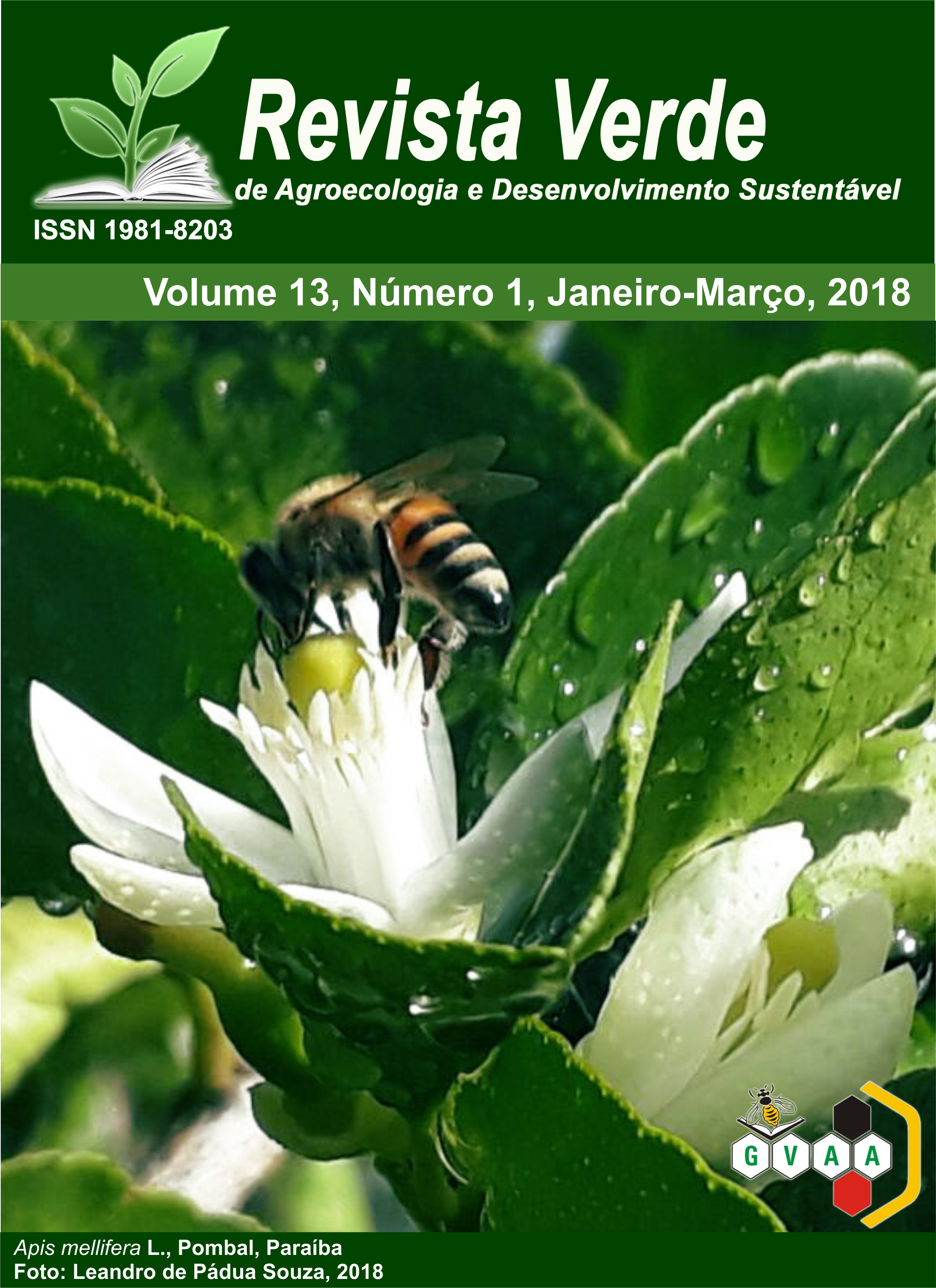Genetic parameters of tomato families F2:3 in resistance to Ralstonia pseudosolanacearum and Ralstonia solanacearum
DOI:
https://doi.org/10.18378/rvads.v13i1.5295Keywords:
Severity, Bacterial wilt, Solanum LycopersicumAbstract
The tomato (Solanum lycopersicum) is an important crop in Brazil, however, it is susceptible to different types of bacteria races. The objective was to study the genetic parameters of 43 F2:3 families of tomato in resistance to R. pseudosolanacearum and R. solanacearum. The families were obtained from the cross between the cultivars Yoshimatsu (resistant) and IPA-7 (susceptible). Two experiments were carried out in a greenhouse at Universidade Federal Rural de Pernambuco, one for each species of the genus R. spp. A randomized block design was used with four replications and 45 treatments. There is less influence of the environment, and greater variability for R. pseudosolanacearum than for R. solanacearum, both among and within families. For R. pseudosolanacearum it is recommended to select 10 days between families, and 20 days between and within families. R. solanacearum should be selected from families only at 20 days. Larger amounts of resistant plants were identified for R. pseudosolanacearum at any time of evaluation than for R. solanacearum.Downloads
References
CARVALHO, A. D. F.; NOGUEIRA, M. T. M.; SILVA, G. O.; LUZ, J. M. Q.; MACIEL, G.M.; RABELO, P. G. Seleção de genótipos de cenoura para caracteres fenotípicos de raiz. Horticultura Brasileira, Vitória da Conquista, v.35, n.1, p.97-102, 2017.
CRUZ, C. D. GENES - a software package for analysis in experimental statistics and quantitative genetics. Acta Scientiarum, Maringá, v.35, n.3, p.271-276, 2013.
DENNY, T. Plant pathogenic R. species. In: GNANAMANICKAM, S. S. (eds.). Plant-Associated Bacteria. New York: Springer, 2006, p.573-644.
ELPHINSTONE, J. G. The current bacterial wilt situation: a global overview. In: ALLEN, C.; PRIOR, P.; HAYWARD, A. C. (eds.) Bacterial Wilt Disease and the R. solanacearum Species Complex. Saint. Paul: American Phytopathological Society Press, p.9-28, 2005.
FELIX, K. C. S.; SOUZA, E. B.; MICHEREFF, S. J. E.; MARIANO R. L. R. Survival of 458 R. solanacearum in infected tissues of Capsicum annuum and in soils of the 459 state of Pernambuco, Brazil. Phytoparasitica, New York, v.40, n.1, p.53-62, 2012.
FERREIRA, P. V. Estatística experimental aplicada a agronomia. 3.ed. Maceió: EDUFAL, 2000. 419p.
FIORINI, C. V. A.; GOMES, L. A. A.; LIBÂNO, R. A.; MALUF, W. R.; CAMPOS, V. P.; LICURSI, V.; MORETTO, P.; SOUZA, L. A.; FIORINI, I. V. A. Identificação de progênies F2:3 de alface homozigotas resistentes aos nematóides das galhas. Horticultura Brasileira, Brasília, v.25, n.4, 509-513, 2007.
KELMAN, A. The relationship of pathogeniciity in Pseudomonas solanacearum to colony appearance on a tetrazolium medium. Phytopathology, New York, v.44, n.5. p.693-695, 1954.
LOPES, C. A.; BOITEUX, L. S. Melhoramento para resistência a doenças bacterianas. In: Fritse-Neto, R.; Borém, A. (eds.). Melhoramento de plantas para condições de estresses bióticos. Viçosa: UFV, 2012, p.61-88.
MAIA, M. C. C.; RESENDE, M. D. V.; PAIVA, J. R.; CAVALCANTI, J. J. V.; BARROS, L. M. Seleção simultânea para produção, adaptabilidade e estabilidade genotípicas em clones de cajueiro, via modelos misto. Pesquisa Agropecuária Tropical, Goiânia, v.39, n.1, p. 43-50, 2009.
MONMA, S.; SAKAT, Y. Inheritance of resistance to bacterial wilt in tomato. Bacterial Wilt. ACIAR Proceedings n045. Australia, p. 149-153, 1992.
MONMA, S.; SAKATA, Y.; MATSUNAGA, H. Inheritance and selection efficiency of bacterial wilt resistance in tomato. Japan Agricultural Research Quarterly, Japão, v.31, n.3, p. 195-204, 1997.
NIELSEN, L. W.; HAYNES, F. L. Resistance in Solanum tuberosum to Pseudomonas 522 solanacearum. American Potato Journal, Washington, v. 37, p.260-267, 1960.
NICK, C.; SILVA, D. J. H. Melhoramento de tomate. In: NICK, C.; BORÉM, A. (eds.). Melhoramento de hortaliças. Viçosa: UFV. p. 396-431, 2016.
PENA, M. A.; NODA, H.; MACHADO, F. M.; PAIVA, M. S. S. Adaptabilidade e estabilidade de genótipos de tomateiro sob cultivo em solos de terra firme e várzea da Amazônia infestados por Ralstonia solanacearum. Bragantia, Campinas, v.69, n.1, p.27-37, 2010.
RAMALHO, M. A. P.; SANTOS, J. B.; PINTO, C. A. B. P.; SOUZA, E. A.; GONÇALVES, F. M. A.; SOUZA, J. C. Genética na Agropecuária. Viçosa: UFV, 2012, p.564.
SANTIAGO, T. R.; LOPES, C. A.; CAETANO-ANOLLES, G.; MIZUBUTI, E. S. G. Phylotype and sequevar variability of R. solanacearum in Brazil, an ancient centre of diversity of the pathogen. Plant Pathology, Havana, v. 66, p. 383–392, 2016
SOUZA, N. M.; BLIND, A. D.; SILVA FILHO, D. F.; RODRIGUES, H. S.; NODA, H. Avaliação de linhagens e cultivares de tomate resistentes à murcha bacteriana (rasltonia solanacearum) desenvolvidas na amazonia. Enciclopédia Biosfera, Goiania, v.9, n.16; p.400-410, 2013.
SOUZA, L. M. S.; MELO, P. C. T.; LUDERS, R. R.; MELO, A. M. T. Correlation between yield and fruit quality characteristics of fresh markert tomato. Horticultura Brasileira, Vitoria dda Conquista, v.30, n.4, 2012.
WICKER, E.; GRASSART, L.; CORANSON-BEAUDU, R.; MIAN, D.; GUILBAUD, C.; FEGAN, M.; PRIOR, P. R. solanacearum strains from Martinique (French west indies) exhibiting a new pathogenic potential. Appl Environ Microbiol, Washington, v.73, n.21, p.6790–6801, 2007.











